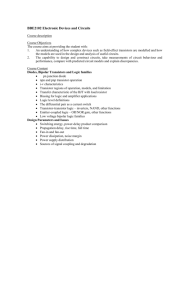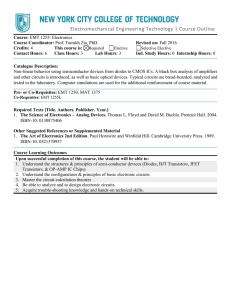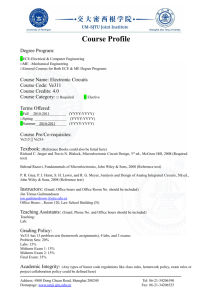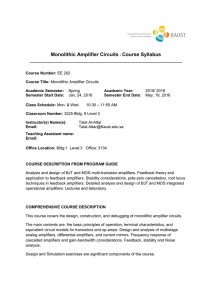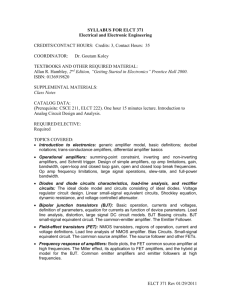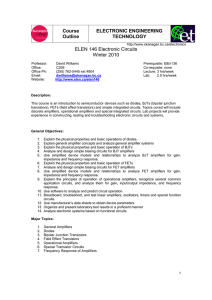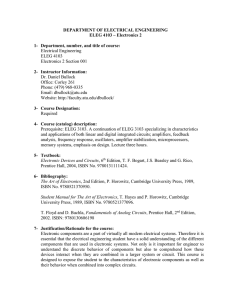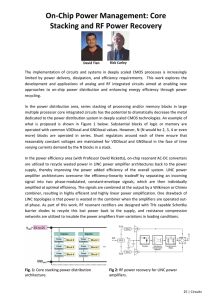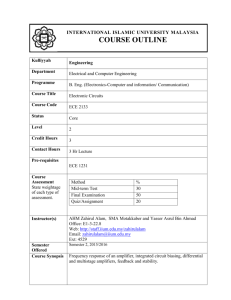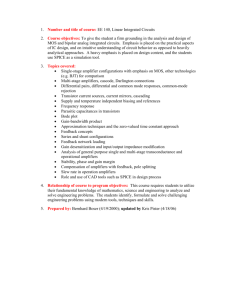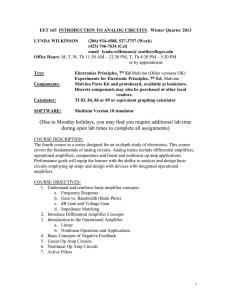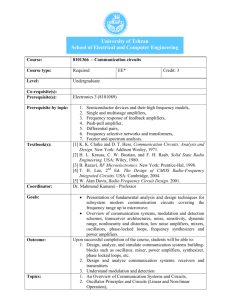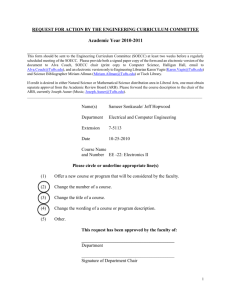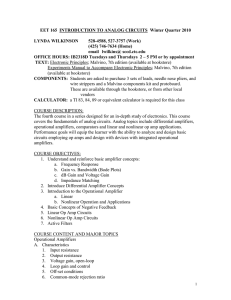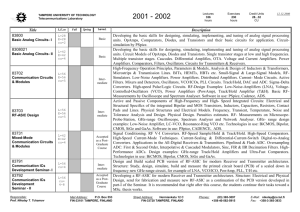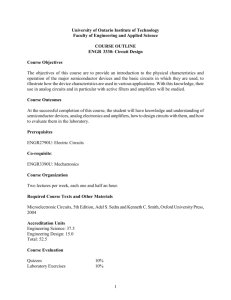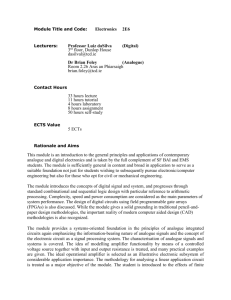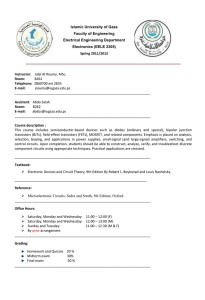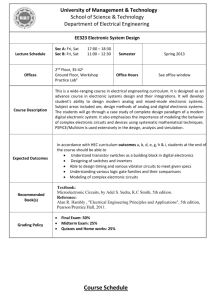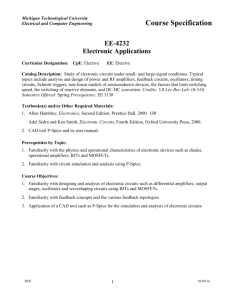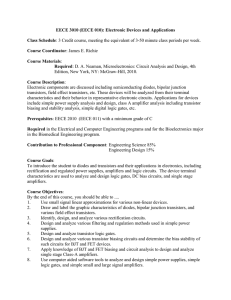INTER AMERICAN UNIVERSITY OF PUERTO RICO
advertisement
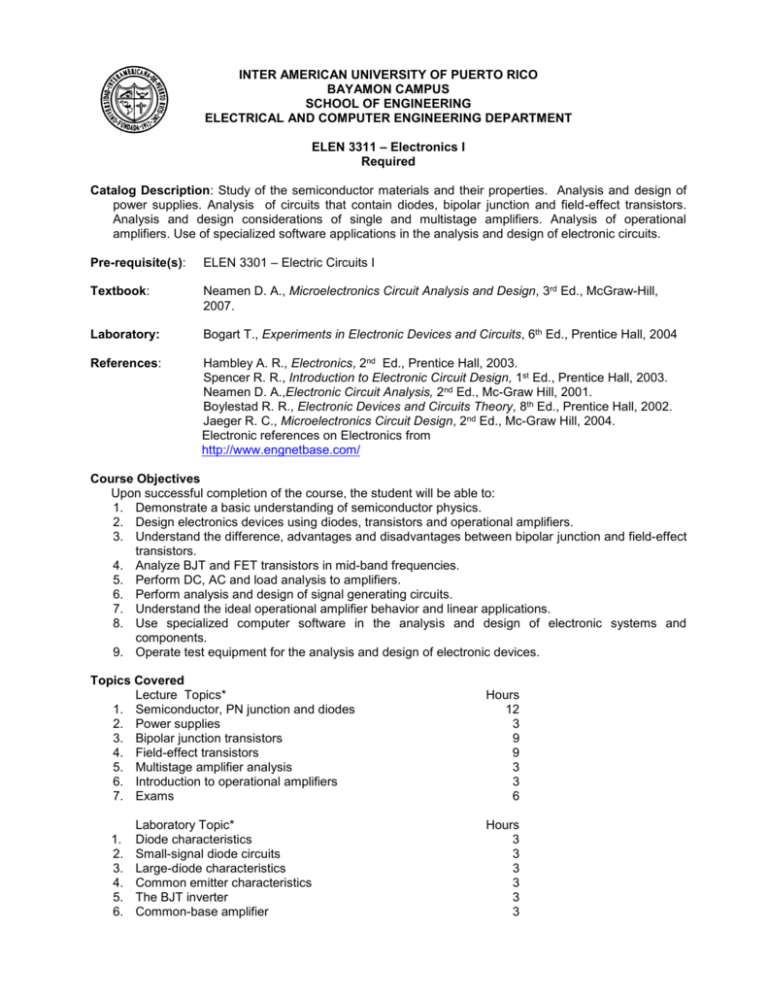
INTER AMERICAN UNIVERSITY OF PUERTO RICO BAYAMON CAMPUS SCHOOL OF ENGINEERING ELECTRICAL AND COMPUTER ENGINEERING DEPARTMENT ELEN 3311 – Electronics I Required Catalog Description: Study of the semiconductor materials and their properties. Analysis and design of power supplies. Analysis of circuits that contain diodes, bipolar junction and field-effect transistors. Analysis and design considerations of single and multistage amplifiers. Analysis of operational amplifiers. Use of specialized software applications in the analysis and design of electronic circuits. Pre-requisite(s): ELEN 3301 – Electric Circuits I Textbook: Neamen D. A., Microelectronics Circuit Analysis and Design, 3rd Ed., McGraw-Hill, 2007. Laboratory: Bogart T., Experiments in Electronic Devices and Circuits, 6th Ed., Prentice Hall, 2004 References: Hambley A. R., Electronics, 2nd Ed., Prentice Hall, 2003. Spencer R. R., Introduction to Electronic Circuit Design, 1st Ed., Prentice Hall, 2003. Neamen D. A.,Electronic Circuit Analysis, 2nd Ed., Mc-Graw Hill, 2001. Boylestad R. R., Electronic Devices and Circuits Theory, 8th Ed., Prentice Hall, 2002. Jaeger R. C., Microelectronics Circuit Design, 2nd Ed., Mc-Graw Hill, 2004. Electronic references on Electronics from http://www.engnetbase.com/ Course Objectives Upon successful completion of the course, the student will be able to: 1. Demonstrate a basic understanding of semiconductor physics. 2. Design electronics devices using diodes, transistors and operational amplifiers. 3. Understand the difference, advantages and disadvantages between bipolar junction and field-effect transistors. 4. Analyze BJT and FET transistors in mid-band frequencies. 5. Perform DC, AC and load analysis to amplifiers. 6. Perform analysis and design of signal generating circuits. 7. Understand the ideal operational amplifier behavior and linear applications. 8. Use specialized computer software in the analysis and design of electronic systems and components. 9. Operate test equipment for the analysis and design of electronic devices. Topics Covered Lecture Topics* 1. Semiconductor, PN junction and diodes 2. Power supplies 3. Bipolar junction transistors 4. Field-effect transistors 5. Multistage amplifier analysis 6. Introduction to operational amplifiers 7. Exams Hours 12 3 9 9 3 3 6 Laboratory Topic* Diode characteristics Small-signal diode circuits Large-diode characteristics Common emitter characteristics The BJT inverter Common-base amplifier Hours 3 3 3 3 3 3 1. 2. 3. 4. 5. 6. 7. Common-emitter amplifier 8. JFET amplifiers 9. Operational amplifiers 10. Design project *Schedule is subject to change 3 3 3 12 Class/Lab Schedule: Four credit hours. Forty-five hour lecture and forty-five laboratory per term. Evaluation Strategies 1. Exams (60%): Two partial exams and a final exam will be scheduled early in the semester. You are expected to take the exams at the times and dates specified. All calculations must be done clearly, stating units and showing a coherent procedure to arrive to the results. 2. Laboratory (18%): Laboratory reports must be submitted by each group, two weeks after the experiment is done. The report must be written in a professional format. 3. Project (17%) A team open design project is required at the end of the course. Partial and final written reports will be submitted. A presentation is required at the end of the semester. 4. Homeworks (5%): Homeworks will be made weekly and are due at the first meeting class of the next week. Solutions will be available to provide immediate feedback. Each student must work individually but team work is also encouraged for challenging problems. Grading Policy Grades are reported according to the following standard grading system: A (90-100), B (80-89), C (70-79), D (60-69), F (0-59) Contribution of Course to Meeting Professional Component Three credit hours of engineering science and three credit hours of engineering design. Relationship of Course to Program Educational Objectives** 1 2 3 √ √ 4 √ Relationship of Course to Program Outcomes** a b c d e f g h i j k √ √ √ √ √ √ √ **The numbers and letters correspond to the Program Educational Objectives and Program Outcomes of electrical engineering, respectively. The program objectives and outcomes can be found in the ECE department website at http://bc.inter.edu/ingeelectrica. Prepared by: Prof. Caroline González Date:1/16/08
